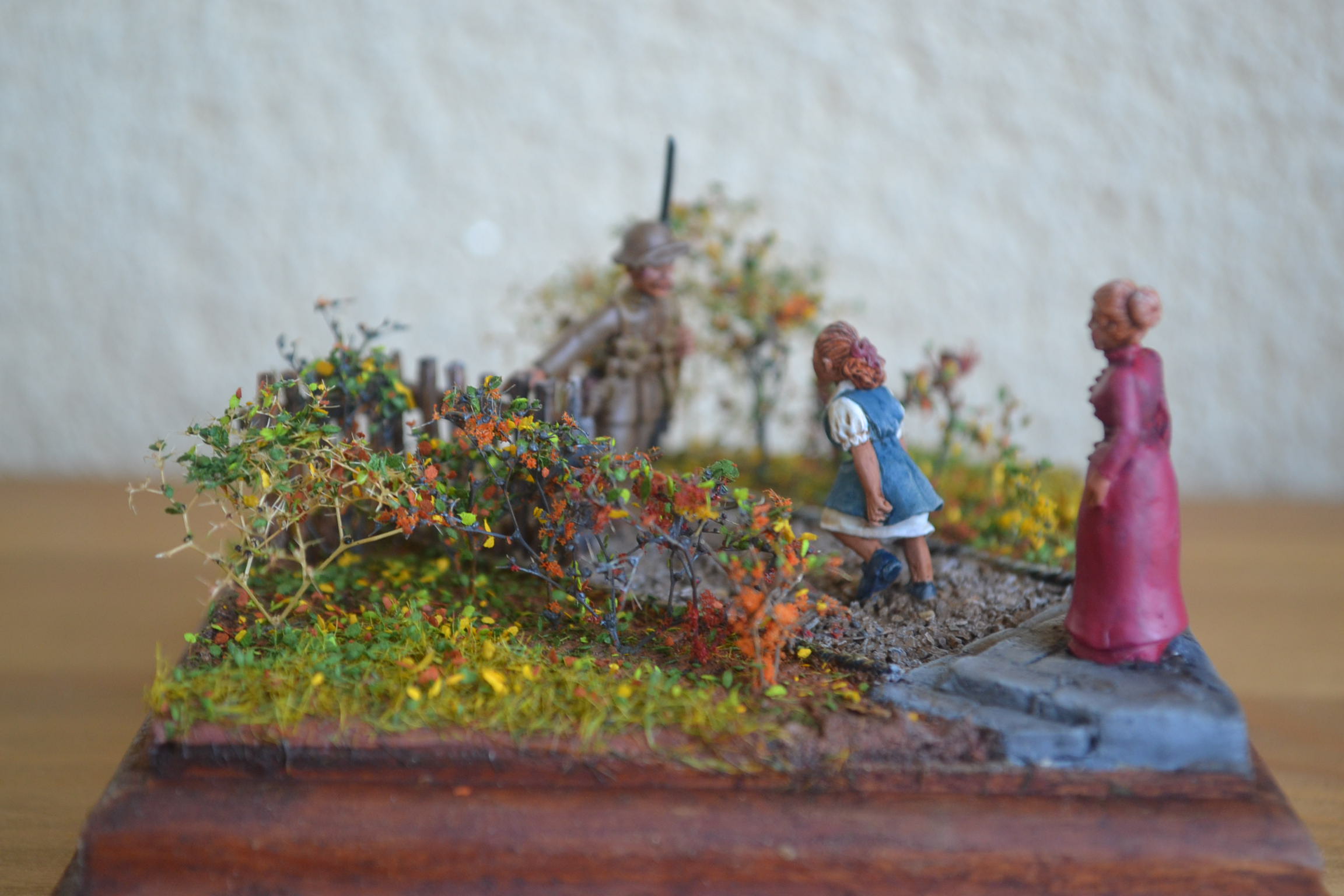A return to my WW1 project this week. An end piece was essential to complete my timeline and I chose a soldier returning home and walking down the front garden path to be met by his excited daughter and his wife.
—000—
28mm WW1 Vignette – “Daddy’s Home!
Today’s second post.
No excuses, I’d simply fallen behind on my WW1 timeline project and needed to get back on track, thus establishing the aim of completing an outstanding item for this week and the next.
Although June is still some time away I can’t believe just how quickly January and February have passed by. As a consequence I did a review of just where I was with this project and my audit indicated that several vignettes and dioramas were complete, some were being worked upon but some had not yet been started. It also struck me that I hadn’t given any further thought to a model which would act as the “end” piece in the sequence.
Obviously the war ending is the stand out incident but was it really the end? In my imagination I envisaged marching troops through London in front of crowds of cheering people but bringing that to life was difficult to get my head around, not least of all because I struggled to find anywhere near the type or number of figures I would have required. I also thought of something very sobering such as a graveyard scene – Gone But Not Forgotten – but whilst I did do one (see an earlier post) I decided that although relevant if was not how I wanted to end the sequence.
In the end I decided on the idea of daddy coming home from the war and being greeted by his wife and child. For many this was the real end of the war, seeing a loved one returning home. More up beat and more personal. So here you have the returning soldier coming down the garden path. Would he have had his rifle? Possibly. Would he have had a fixed bayonet? Almost certainly not! I did think to remove it but on closer inspection I thought I would almost certainly cock it up so felt it was better left alone! It’s the story that’s relevant not the accuracy. That’s my excuse any way!
So now I have a beginning and an end to my timeline and but need of a few more for inbetween. No time for slacking as the clock continues to tick.
TIM









seen this before but it still hits home, love this diorama, very well executed and the subject is ace.
Would like to see you do a diorama featuring a guided tour with a few folks, a half hidden trench on a grassy knoll and poppies coming out the ground, well what you waiting for..
LikeLiked by 4 people
That’s not a bad shout Steve. I really like the idea of a poppy field. You have got me thinking about that one, it would make for a nice addition to the sequence. A few things to concentrate on first but that has definately been added to the list! 🤗
LikeLiked by 4 people
Daddy actually came home…
Great diorama, superb painting-skills on the expressions, also the coloration of the face with the reddish-tone of emotion – he really looks like he’s about to cry.
The way looks fantastic, I’m striving to get mine done as yours, when I’m attempting one.
I agree on you with the bayonet: The one used by the Brits in WW1 was kind of special, as it had been designed – you might laugh – with the Japanese Katana. The thought was that, if the blade is especially long and a bit curved, it would give you an edge of the battlefield. As battles were totally not decided by mass-charges (the French, who called them “Élan” did learn this in 1870 already, as the German allies didn’t care much about those) and trench-warfare became the norm, every army – including the German of course – quickly did away with them. If I recall the Matt Easton video (or was it some American-one?) correctly, the Brits would preferredly use newly designed combat-knifes (the US as well) and probably Grenades while the Germans loved their trusty entrenching-tool – the shovel!!!! or collapsible spade(Klappspaten), knives and of course grenade-packs. At this point you might think, that an elongeated pointy-stick might be working well from above the trenches, but it simply didn’t, as you would have been simply shot and inside the trench the bayonet was easily deflected or got stuck in a wall.
LikeLiked by 3 people
I should really read, what I type, before I push “send”: “I agree on you with the bayonet: The one used by the Brits in WW1 was kind of special, as it had been designed – you might laugh – with the Japanese Katana.” – “I agree with you on the matter of the probably missing bayonet: The one used by the Brits in WW1 was kind of special, as it had been designed – you might laugh – with Japanese Katana in mind.” Additionally: But he still might’ve kept it till the end of the war, as you weren’t really allowed to just leave your stuff on the battlefield, as it most often was state-property that was later given to the veterans, so they could “remember”. German Veterans 1918 also came back with many parts of the 1914 uniform, for example for the most part of the war, none of them used the backpacks, but in 1918, those who returned, returned with it, and of course their bayonets.
LikeLiked by 3 people
Your history is on a far higher level than mine but I do love to read such things. Seems having the bayonet might have been right after all but I suspect it would not have been on the rifle itself perhaps. That said it is the interpretation that counts and I’m glad you like this little model.
LikeLiked by 3 people
I wouldn’t say that, I have just that strange gift of remembering historical facts easily, if I ever saw or heard of them. My memory is unfortunately as good anywhere else. 😉
I don’t see why he wouldn’t, maybe to not hurt anyone, but otherwise holstering the bayonet on the gun is parade-like, and as a veteran I’d would want to face my family at my best. 🙂 There is a saying about realism and “art” or better story-telling: It doesn’t has to be completely authentic, but it hast to be convincing, and that it is. Really well done!
LikeLiked by 3 people
Yes I have heard something along those lines too and very much sums up my thinking. It’s the representation that counts.
LikeLiked by 3 people
Great diorama- loved it the first time round.
Cheers,
Pete.
LikeLiked by 3 people
Thanks Pete.
LikeLiked by 2 people
Ah the bayonet rears up again HA HA ,and boy has it given us some interesting information so you have done well there Dave ,that’s what its all about, not only entertainment but educational as well. I must say when I first saw this I was just getting into foliage and seeing this one again has drawn my attention to the hedge ,so well done mate what did you use for the leaves?
LikeLiked by 3 people
Thanks Pat, so much more to this hobby of ours isn’t there? The leaves came from a company called Noch. I think they do stuff for railways if I remember correctly. I use the leaves on my wire trees too.
LikeLiked by 3 people
Ah, I should have known that as I have used their products before, they certainly did the trick.
LikeLiked by 2 people
Love it Dave
LikeLiked by 2 people
Cheers Steve. Hope you feel better soon.
LikeLiked by 1 person
The emotions in this diorama are really strong. I love the detail with him holding the fence and the shrubs (or whatever the proper name would be for the plants) are beautiful and underscore the emotions of the scene. Excellent work, as always! 🙂
LikeLiked by 2 people
Thank you.
LikeLiked by 2 people
I remember the command “fix bayonets”! Yeah, that would have been in the scabbard, but the rifle and the bayonet would likely be back in the unit arms room. But that’s not to take anything away from the emotion that this lovely piece brings forth. I do know what it’s like to come home from a long deployment to see your family, and this piece nails that. Brilliant.
LikeLiked by 1 person
Thanks Mark. An emotional moment for sure. Closest I’ve come to experiencing it was returning from Australia where I had been for a month!
LikeLiked by 1 person